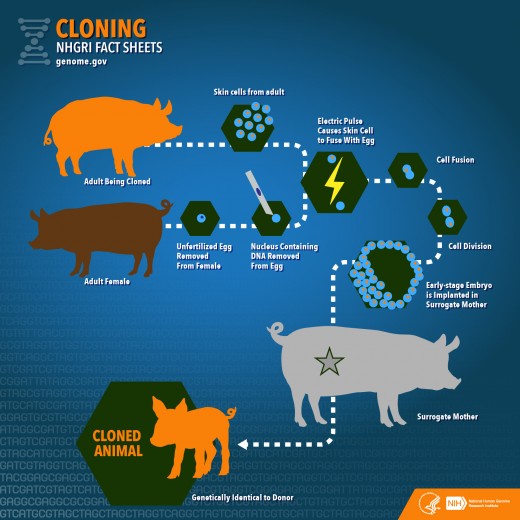Cloning: Messing With the Human Genome. Should We Do It?

To Clone or Not to Clone?
Is unethical to clone for stem cell research? There has always been a debatable issue on cloning since the research started over 40 years ago (Jones 1). I would like to concentrate specifically on cloning for stem cell research. Most say it is unethical and others fight that science can beat out nature if we look deep enough into the field. Some even think sooner or later we will be able to stop death, but that is an entirely different subject. First and foremost there is the question can or can’t we do it, followed by is it ethical or not.
The answer is no, it isn’t. Embryos are created for the purpose of life and are often created in a natural way involving sexual intercourse and the infusion of the sperm and ovum. This is the way it has always been. If a couple couldn’t have a baby, it was unfortunate, but it was thought that there was a reason. Some people would say it is faulty genetics, and they are not meant to reproduce. It wasn’t until later that in utero fertilization occurred. This was a major breakthrough for people who couldn’t produce offspring by the traditional method, but at the same time went against all laws of nature. By this I mean people who could not reproduce of 100% natural methods.
The process of in utero hasn’t varied much since the discovery of how to successfully implant a fetus or “test tube baby” into a live specimen. They start with a large amount of ovum, usually about seven to ten eggs, and they fertilize them using the nucleus from one parent; this is called therapeutic cloning. They then grow the cells in a lab until they are sixty four cells, then they evaluate the healthiness of the cells to determine which of the embryos are the best candidates for the transfer (Jones 3). Out of the ten fertilized ovum, two might be of healthy enough for transfer. So what do they do with the other eight? They use them for stem cell research. This is great for the furthering of science, but is it ethical for the fetuses that will be killed in the process?
By all the religious or ethical laws we were are taught to believe in at a young age, no this isn’t ethical, although it is a matter of personal ethics. Some think that furthering scientific data brings means to the end. Unfortunately, lives are lost regardless of your personal ethics. These embryos are usually killed, due to constant removal and testing of their cells. The embryos die at just a mere five to seven days old. All of these excess fetuses, who were originally conceived to become life, are terminated before they have a chance to live. What a waste of souls it is.
During the course of my research I came across an interesting quote from Michael Sandel who wrote an article called “Embryo Ethics” In this article he says,
“It is important to be clear, first of all, about the embryo from which stem cells are extracted. It is not implanted and growing in a woman's uterus. It is not a fetus. It has no recognizable human features or form. It is, rather, a blastocyst, a cluster of 180 to 200 cells, growing in a petri dish, barely visible to the naked eye. Such blastocysts are either cloned in the lab or created in fertility clinics.... Congress would fund stem cell research only on excess blastocysts left over from infertility treatments (Sandal 1).”
So, if these groups of cells aren’t really fetuses, what are they? They are alive correct? They grow with every passing day. They need nutrition to become healthier. That is all the things a fetus needs as well.
Putting these facts aside, there have been great success stories in cloning trials. There are 5 mammalian species that have shown great results in extensive reproductive cloning studies. These species include sheep, cattle, pigs, goats, and mice. However, these experiments have problems as well. Very few cloning experiments are successful, and when they fail, you see problems such as severe birth defects or death before the fetus is born or shortly after birth. Also, the hosts have shown complications including death from carrying cloned fetuses (Hanna 1).
There has been very promising results with the use of stem cell research for diseases such as Alzheimer’s, Parkinson’s, heart disease, stroke, and diabetes (Jones 2). However, in one known case of Parkinson’s, a man died after a transplant of embryonic cells. It was later found that the cells had caused abnormalities in his bone, skin, hair, and brain (Jones 4). Advancing these treatments further could mean more time for someone suffering from these diseases but even less time and a greater amount of terminations of fetuses due to testing and research.
Even though there have been great success in clinical trials, there are side effects to the transplants. The most common are uncontrollable movements, such as head-jerking, writhing, and constant chewing. There is an instance of a patient that is now “tube –fed” because his symptoms were so severe (Jones 4).
It wasn’t until recently that they discovered the potential of stem cell research being fueled by adult tissue samples. It was once believed that there were few to no stem cells available from adult tissue, but adult stem cells have, in fact, been used in procedures such as bone marrow transplants for decades. There have also been new trials on patients using adult stem cells that have had positive results. Removing adult and embryonic stem cell research from the equation, most supporters and opposers of stem cell research agree that the ultimate goal should be using the patient’s own cells. Even though embryonic cells have a lower rate of complications, there is still a chance that the body will reject the cells and cause the patient to have a severe response with in the immune system (Jones 3).
There are a variety of ways that adult stem cells can be used. They are collected from a donor, or the patient itself, and used in bone marrow transplants without alteration of the original cell. It has a different effect on children, and the cells are manipulated by gene therapy before being introduced into the new host. This method is commonly used for children with Severe Combined Immune Deficiency (Jones 3).
Treatment of patients using adult stem cells has already had results. Successful treatments have been found through research on children with cartilage defects, patients with corneal scarring, systematic sclerosis, rheumatoid arthritis, and lupus. Some cancer cells are responding also, particularly metastatic retinoblastoma, which normally has a poor prognosis with normal treatment (Jones 4). Michael Fumento, associate of the Competitive Enterprise Institute, said
“The reason that public opinion favors embryonic stem cell research is that people are ignorant of the facts: adult stem cells routinely treat or cure 80 different diseases, while embryonic stem cells are largely untested. The media are responsible for this injustice because they are lazy, intolerant of religious values, and manipulated by the embryonic stem cell research industry. The truth is that adult stem cell research is currently having more real breakthroughs and treating more diseases than embryonic stem cell research (Fumento 1).”
On the four front of embryonic research is Jonathan Moreno of Pennsylvania University. He says “Scientists do not think of research using embryonic and adult stem cells as separate enterprises, but rather as different tools in regenerative medicine—the use of cells from a variety of sources to cure diseases, learn more about human development, and more effectively develop drugs (Moreno 1).”
Stem cells have been recently introduced in a new way when looking for better ways to help people. For example, a patient with heart disease given stem cells from a muscle in his leg would form a different kind of muscle in his heart. Adult bone marrow samples are extremely versatile and can produce bone, cartilage, tendon, muscle, fat, liver, and neural cells. Neural cells can form other cell types as well, such as blood and muscle cells (Jones 3).
It is very difficult to produce a healthy offspring from the use of cloning. Several hundred fetuses would die for one to be born. Problems arise at every step of the development in producing embryos by cell nuclear replacement. The few examples are a high rate of miscarriages of clones, a high rate of neonatal death and major fluid retention in the mother. Most term offspring have developmental delays, heart and lung defects, malfunctioning immune systems, and excessive size (Jones 5).
The high rate of issues and abnormalities in cloning gives us reason to fear its use on human patients. In short, embryonic cells are unstable and difficult to control.
Some embryos that are fertilized are in excess to a couple’s requirements. These fetuses are referred to as IVF embryos (Hanna 2). These embryos are specially made for the use of in utero conception. However, they are created in large groups, and usually parents are only looking for one healthy embryo, in which case the others will be terminated. Scientists see this as an opportunity. Since these fetuses are going to “die anyway” they try to get some use out of them, torturing them until the point of fatality. We should take note of the fact that this would be unacceptable in any other case of human beings threatened with imminent destruction. It is morally incorrect to take a man on death row, or a patient who is dying but not dead and use up their available resources (Jones 8). This is seen as torturous, dangerous, and disrespectful to use them as mere organ donors with total disregard for their lives. So why should embryos be any different?
Ethics have and will always be debated, but to me, it’s cut and dry. Embryos should not be created to be led to their death for scientific testing. Embryos have rights just like any other living creature, they have the right to live and survive just as we have, even though they might not have a conscience mind when their life is stolen. We would be naive to think that underdeveloped life has any less right to live than we do. In any case, science will prevail if voices of justice for the unborn are not heard.
References
Fumento, Michael. "Adult Stem Cells Are More Valuable than Embryonic Stem Cells."
Citizen Magazine (May 2005). Rpt. in Embryonic and Adult Stem Cells. Ed. Margaret Haerens. Detroit: Greenhaven Press, 2009. At Issue. Gale Opposing Viewpoints In Context. Web. 17 Nov. 2010. Adult stem cells facts vs. embryotic.
Hanna PHD, Kathi E. “Cloning/Embryotic Stem Cells.” Genome. National Human genome Research Institute, Apr. 2006. Web. 23 Sept. 2010. <http://www.genome.gov>. IVF facts.
Jones, David. “Healthcare Ethics.” The Linacre Center. The House of Lords, 2000. Web. 19 Sept. 2010. <http://www.linacre.org>. Ethics of stem cell research on embryos.
Moreno, Johnathan. "Despite Advances Embryonic, Not Adult, Stem Cells Are More Valuable." Embryonic and Adult Stem Cells. Ed. Margaret Haerens. Detroit: Greenhaven Press, 2009. At Issue. Gale Opposing Viewpoints In Context. Web. 17 Nov. 2010. Argues embryonic cells are more viable.
Sandel, Michael J. "The Government's Policy Regarding Stem Cell Research Is Contradictory." Boston Globe (8 Apr. 2007). Rpt. in Embryonic and Adult Stem Cells. Ed. Margaret Haerens. Detroit: Greenhaven Press, 2009. At Issue. Gale Opposing Viewpoints In Context. Web. 17 Nov. 2010. Policy from a government standpoint.
Make your Opinion Heard
Do you agree that we should clone for stem cell research?
This content is for informational purposes only and does not substitute for formal and individualized diagnosis, prognosis, treatment, prescription, and/or dietary advice from a licensed medical professional. Do not stop or alter your current course of treatment. If pregnant or nursing, consult with a qualified provider on an individual basis. Seek immediate help if you are experiencing a medical emergency.
© 2018 Lain Golden








